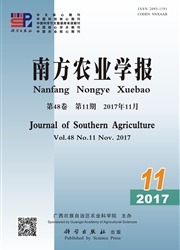

 中文摘要:
中文摘要:
【目的】明确新疆地区牛源耐甲氧西林金黄色葡萄球菌(MRSA)流行株的流行特点,为有效防控新疆奶牛乳房炎和子宫内膜炎提供参考依据。【方法】采用分离培养、生化鉴定、药敏试验等方法对牛源MRSA进行鉴定,并以PCR扩增牛源MRSA新疆流行株spa基因的X区,测序结果列提交至spa分型数据库(http://www.ridom.de/spaserver/)进行spa基因多态性分型。【结果】从221份样品中共检测出71株金黄色葡萄球菌,其中对苯唑西林抑菌直径小于10mm的有8株;而以mecA引物进行PCR扩增,发现扩增结果呈阳性的有13株,MRSA检出率为18.3%。spa基因分型有4种,分别为t779、t2883、t13751和t1939,其中5株为t779(r08),4株为t2883(r07-r23-r21-r17-r34),2株为t13751(r07-r23-r12-r21-r17-r12),2株为t1939(r07-r23-r02-r34),即t779(r08)为MRSA新疆流行株的主要spa基因分型。【结论】MRSA在新疆不同地区均有分布,且其耐药情况不断变化,以t779(r08)为MRSA新疆流行株的主要spa基因分型。
 英文摘要:
英文摘要:
【Objective】The aime of the study was to study epidemiological characteristics of methicillin-resistant Staphylococcus aureus(MRSA)isolated from bovine in Xinjiang,and provide reference basis for effective prevention and control of dairy cows mastitis and endometritis in Xinjiang.【Method】Differential culture,biochemical identification and drug sensitive test were applied to identify MRSA,and X region of spa gene from MRSA epidemic isolate in Xinjiang was amplified.The sequencing results were submitted to spa genotype database(http://www.ridom.de/spaserver/)for spa polymorphism genotyping.【Result】Seventy-one S.aureus isolates were selected from two hundred and twenty-one samples.Among them,bacteriostatic diameter of eight strains for oxacillin was less than10mm.PCR amplification was conducted with mecA primer,13strains were positive,the detection rate of MRSA were18.3%.Four spa genotypes were detected:t779,t2883,t13751and t1939.Five strains were t779(r08),four strains were t2883(r07-r23-r21-r17-r34),two strains were t13751(r07-r23-r12-r21-r17-r12)and two strains were t1939(r07-r23-r02-r34).In another word,t779(r08)was the predominant spa genotype among MRSA epidemic isolates in Xinjiang.【Conclusion】MRSA is distributed in different regions of Xinjiang,and its drug resistance changes constantly.t779(r08)is the predominant spa genotype among MRSA epidemic isolates in Xinjinag.
 同期刊论文项目
同期刊论文项目
 同项目期刊论文
同项目期刊论文
 期刊信息
期刊信息
